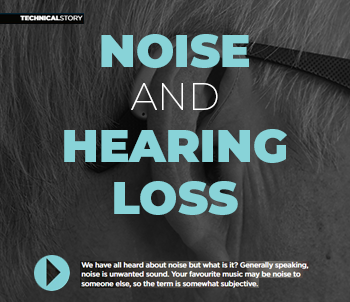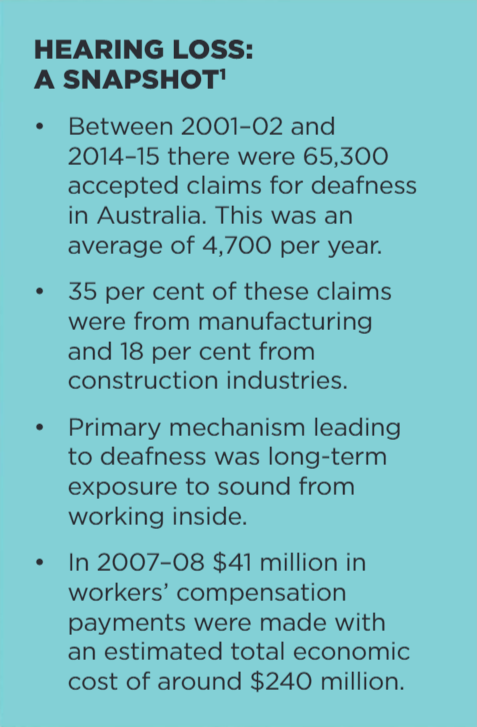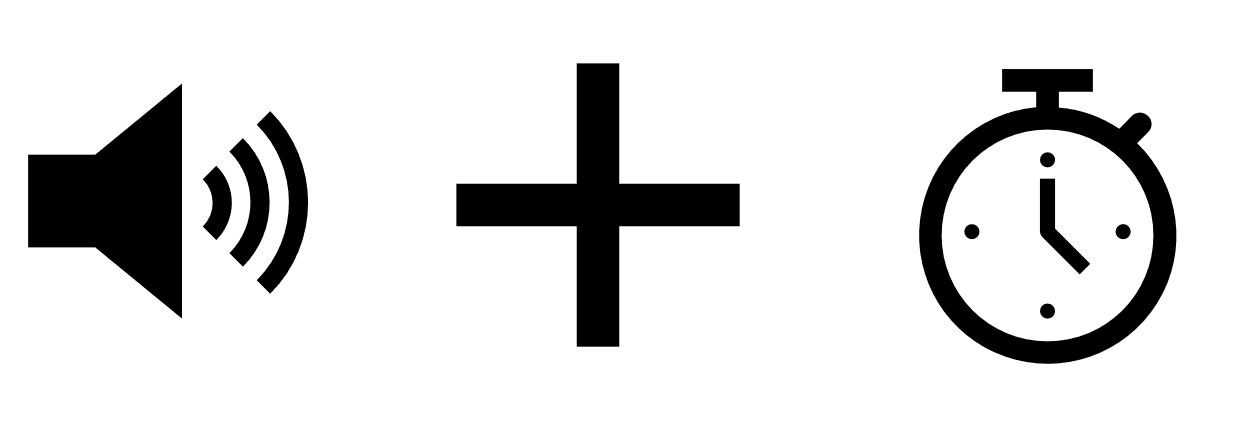Noise and Hearing Loss: what to know at work
 By Bill Morrissey
By Bill Morrissey
Master Electricians Australia, published in Circuit magazine.
We have all heard noise, but what is it? Generally speaking, noise is unwanted sound. Your favourite music may be noise to someone else, so the term is somewhat subjective.
Excessive noise whether in the workplace, at home, or at events presents a risk of hearing damage and other health problems. People exposed to excessive noise may develop tinnitus, (described as a constant ringing sound) or at the extreme, deafness. For most cases of noise-induced hearing loss, there is no cure.
 Whilst the best approach for noise management is to eliminate the source, frequently in an electrician’s work environment, this is not always possible due to us not having control over the source of the noise. Large construction sites where multiple trades may be working in the vicinity frequently present noise exposure not caused by the electrician. Similarly, as a maintenance contractor in an industrial workplace, you may be exposed to noise caused by your customer’s equipment. Frequently we have to resort to the least preferred hazard control method – PPE and use of hearing protection such as earplugs and muffs.
Whilst the best approach for noise management is to eliminate the source, frequently in an electrician’s work environment, this is not always possible due to us not having control over the source of the noise. Large construction sites where multiple trades may be working in the vicinity frequently present noise exposure not caused by the electrician. Similarly, as a maintenance contractor in an industrial workplace, you may be exposed to noise caused by your customer’s equipment. Frequently we have to resort to the least preferred hazard control method – PPE and use of hearing protection such as earplugs and muffs.
Think of hearing protection a bit like sun protection. Noise can harm your hearing in a short time, just like you can get sunburnt after being in the sun for a few hours. If your ears have ever had ringing or your hearing has felt dull after being exposed to noise, then you have likely experienced the hearing equivalent of sunburn. Just like your skin recovers from the short-term effects of sunburn (redness and soreness), your ears also appear to recover from the short-term effects of noise (ringing and dullness)- but we know sunburn can cause lasting damage, so to can noise.
More from MEA
- What to do before holiday closedown
- Stay safe when working in ceilings
- Solar installer fined for unsafe workplace

The louder the noise and longer you listen, the greater the chance of damaging your hearing. As you listen to loud sounds without hearing protection the time you can safely listen quickly reduces, for example:
60dB(A) – Normal conversation – No time limit
85dB(A) – Busy Road2 – 8 Hours – (General 8-hour exposure level)
100dB(A) – Nightclub2 – 15 Mins
110dB(A) – Chainsaw2 – 1 Min
 Protecting your hearing
Protecting your hearing
Protect your hearing by limiting how you protect your hearing depends on how long you listen to loud sounds combined with how loud the sound is.
To protect your hearing:
- Take time out every now and then from noisy activity
- Wear earplugs or muffs and learn to fit them properly
The workplace is not the only cause of noise-induced hearing damage:
- Mowing the lawn
- Circular Saw
- Concerts
- Sporting Events- i.e. V8’s
- Shooting
- Personal Music Devices
Tips for safe music listening:
- Listen at a volume where you can hear someone and communicate at arm’s length without having to shout.
- Don’t listen at 100 per cent volume on your device – these levels can cause damage after only three minutes (depending on the type of headphone you are using)3
- Limit the noise around you.
- Use noise-limiting headphones.
- Use earplugs at music venues or sporting events
Other causes of Hearing Loss:4
Vibration
Studies have indicated that there is a link between exposure to hand-arm vibration and hearing loss. Workers who use equipment such as chainsaws that subject the worker to both hand-arm vibrations and to noise may be more likely to suffer from hearing loss. Other tools that may expose workers to both noise and hand-arm vibration include:
- pneumatic and electrical rotary tools such as concrete breakers, grinders, sanders, and drills
- percussive tools such as chippers and riveters
- petrol-powered tools such as lawnmowers, brush cutters, and chainsaws
- vibrating plates and compactors
Ototoxic substances
Exposure to some chemicals can result in hearing loss. These chemicals are known as ototoxic substances. Hearing loss is more likely to occur if a worker is exposed to both noise and ototoxic substances than if exposure is just to noise or ototoxic substances alone.
There are three major classes of ototoxic substances: solvents, heavy metals, and asphyxiants.
Work activities that commonly combines noise and ototoxic substances include:
- painting
- printing
- boat building
- construction
- furniture making
- re-fueling vehicles and aircraft
- manufacturing, particularly of metal, leather and petroleum products
- degreasing
- firefighting
Acoustic Shock
Acoustic incidents are sudden, unexpected loud noises occurring during telephone headset use including crackles, hisses, whistles, shrieks or high-pitched noises. Acoustic shock is not caused by the loudness of a telephone, as all phone noise is electronically limited to a peak noise level of 123 decibels, but by a sudden rise in noise levels.
Sound connects us with our world. The effects of even a mild hearing loss should not be underestimated.
The tell-tale signs of hearing loss:
- Difficult to follow a conversation. Hearing loss usually begins with a loss of clarity rather than overall volume
- People with softer voices sound unclear
- It’s hard to distinguish voices on TV shows when there’s competing noise
- Having to continually ask people to repeat themselves
- Having trouble hearing people when they are not facing you, speaking from a distance or from another room
One of the biggest safety issues in our industry and across most places of work is the risk of falls and falling from heights
Research shows that there is a significant association between hearing loss and falling.
Individuals with a mild hearing loss (25 decibels) have been shown to be nearly three times more likely to have a history of falling than those with no hearing loss. Each additional 10 decibels of hearing loss, increases your risk of falling by 1.4 times.5
Hearing loss raises the potential for falls due to decreased awareness of the surrounding environment and increased cognitive load. This increase causes the brain to become overwhelmed with the demands on its resources to maintain balance and gait, while simultaneously straining to process auditory input.
Employer responsibilities
Under each state or territory WHS legislation, the PCBU (Person Conducting a Business or Undertaking) is required to manage the risk of noise-induced hearing loss in a workplace. This requires the PCBU to assess workplaces for noise and eliminate, reduce or mitigate the causes or effects. This may include, for example, replacing noise sources with quieter ones, rearranging job processes to reduce exposure, providing suitable training and PPE for employees to recognize and manage potential noise sources and for hearing damage.
Employee responsibilities
Legislation requires employees to work with the PCBU to protect their hearing whilst at work. This is achieved by following company policies and procedures, using the machinery and PPE provided by the employer, maintaining PPE in accordance with manufacturers’ instructions and advising the employer if they become aware of any hazards or problems.
Audiometric testing
Under the model WHS Regulations, a PCBU must provide audiometric testing for a worker who is carrying out work if they are required to frequently use personal hearing protectors as a control measure for noise that exceeds the exposure standard.
Audiometric testing must be provided within three months of a worker starting work that exposes them to a risk of work-related noise-induced hearing loss.
Starting the audiometric testing before people are exposed to hazardous noise (such as new starters or those changing jobs) provides a baseline as a reference for future audiometric test results.
Regular follow-up tests must be carried out at least every two years. These should be carried out well into the work shift so that any temporary hearing loss can be identified.
Please reduce your Risk of Hearing Loss.
If you have questions about safety on your worksite Master Electricians have unlimited access to the MEA Safety Hotline. Phone 1300 889 198 and speak direct to the experts.
-
- Safe Work Australia, Noise, accessed 06 May 2020
- ‘National Code of Practice for Noise Management and Protection of Hearing at Work’ 3rd Edition
- Keith, S.E., Michaud, D.S.G & Chiv, V, 2008, Evaluating the maximum playback sound levels from portable digital audio players
- Work Health and Safety Queensland, Managing noise and preventing hearing loss at work. Code of Practice 2011
- Bradley, C., 2013, Hospitalisation due to falls by older people
- Safe Work Australia, Noise